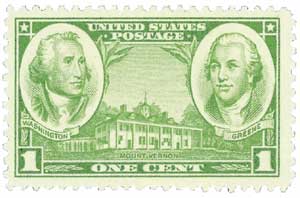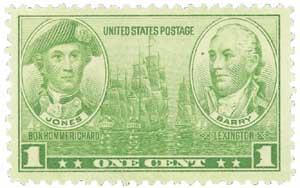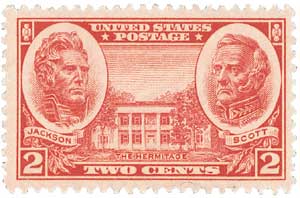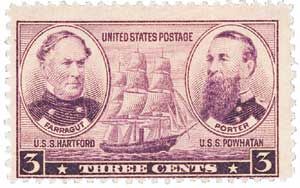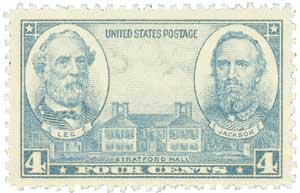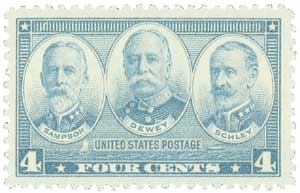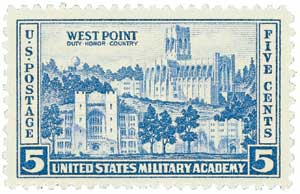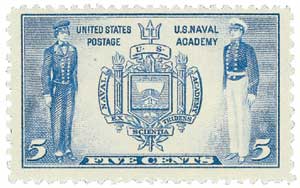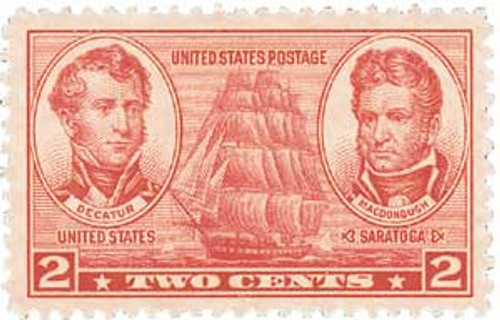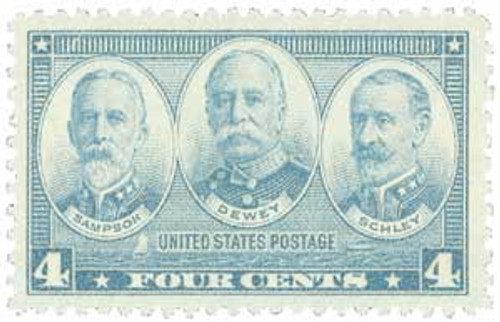
# 785 PB - 1936 1c Army and Navy: Washington and Greene, Mt Vernon
1936 1¢ Washington & Green
Army and Navy
Issue Date: December 15, 1936
First City: Washington, DC
Quantity Issued: 105,196,150
Army & Navy Issue
The idea for a set of stamps honoring America’s military heroes wasn’t a new one. Years earlier, President Theodore Roosevelt had suggested such a series of stamps, but nothing was done during his term.
| Click on any of these images to find more conditions and First Day Covers for your collection. |
Then, Franklin Roosevelt was elected president in 1932. An avid stamp collector since childhood, he pushed for the creation of more stamps and often submitted his own design and topic suggestions. Among those suggestions was the Army and Navy Commemorative Series. It honors notable military leaders from the Revolutionary War through the Spanish American War. Five stamps honor the Army and five honor the Navy.
The first stamps in the series were issued on December 15, 1936. US #785 pictures George Washington, Nathanael Greene, and Washington’s home, Mount Vernon. Also issued on that day, #790 pictures Navy heroes John Paul Jones, John Barry, and their ships the Bonhomme Richard and the Lexington.
The second pair of stamps was issued one month later, on January 15, 1937. The Army stamp pictures Andrew Jackson, Winfield Scott, and Jackson’s home, the Hermitage. The Navy issue pictures Stephen Decatur and Thomas MacDonough with a contemporary warship.
The third set of stamps was issued on February 18, 1937. The Army stamp honors three Civil War generals – William T. Sherman, Ulysses S. Grant, and Philip Sheridan. The Navy stamp pictures adopted brothers David Farragut and David Porter. It also lists each man’s most notable ship – the USS Hartford and the USS Powhatan, and pictures a warship from the era.
The fourth set was issued on March 23, 1937. The Army stamp was the most controversial in the series as it pictured Confederate generals Robert E. Lee, Stonewall Jackson, and Lee’s birthplace, Strafford Hall. When it was first announced, a rumor had spread that the stamp would also picture Jefferson Davis. After it was issued, Southerners protested the stamp because Lee only had two stars (instead of three), even though it was a simple mistake because of a design change. The Navy stamp issued on that day pictured three heroes of the Spanish-American War – Admirals William Sampson, George Dewey, and Winfield Schley.
Issued on May 26, 1937, the fifth set was quite different from all the earlier issues. They were the only stamps in the set to not honor specific military men, rather, they honored each branch’s respective military academy. They were also the first stamps in the set not issued in Washington, DC. They were issued at each academy. The Army stamp pictures the US Military Academy at West Point and includes the school motto, “Duty, Honor, Country.” The other stamp honors the US Naval Academy in Annapolis, Maryland. It pictures the school seal and two midshipmen – one in the uniform from the school’s early days, and one from the time the stamp was issued.
| Want the complete set of Army-Navy stamps? Click here to order. |
American Revolutionary War General
1936 1¢ Washington & Green
Army and Navy
Issue Date: December 15, 1936
First City: Washington, DC
Quantity Issued: 105,196,150
Army & Navy Issue
The idea for a set of stamps honoring America’s military heroes wasn’t a new one. Years earlier, President Theodore Roosevelt had suggested such a series of stamps, but nothing was done during his term.
| Click on any of these images to find more conditions and First Day Covers for your collection. |
Then, Franklin Roosevelt was elected president in 1932. An avid stamp collector since childhood, he pushed for the creation of more stamps and often submitted his own design and topic suggestions. Among those suggestions was the Army and Navy Commemorative Series. It honors notable military leaders from the Revolutionary War through the Spanish American War. Five stamps honor the Army and five honor the Navy.
The first stamps in the series were issued on December 15, 1936. US #785 pictures George Washington, Nathanael Greene, and Washington’s home, Mount Vernon. Also issued on that day, #790 pictures Navy heroes John Paul Jones, John Barry, and their ships the Bonhomme Richard and the Lexington.
The second pair of stamps was issued one month later, on January 15, 1937. The Army stamp pictures Andrew Jackson, Winfield Scott, and Jackson’s home, the Hermitage. The Navy issue pictures Stephen Decatur and Thomas MacDonough with a contemporary warship.
The third set of stamps was issued on February 18, 1937. The Army stamp honors three Civil War generals – William T. Sherman, Ulysses S. Grant, and Philip Sheridan. The Navy stamp pictures adopted brothers David Farragut and David Porter. It also lists each man’s most notable ship – the USS Hartford and the USS Powhatan, and pictures a warship from the era.
The fourth set was issued on March 23, 1937. The Army stamp was the most controversial in the series as it pictured Confederate generals Robert E. Lee, Stonewall Jackson, and Lee’s birthplace, Strafford Hall. When it was first announced, a rumor had spread that the stamp would also picture Jefferson Davis. After it was issued, Southerners protested the stamp because Lee only had two stars (instead of three), even though it was a simple mistake because of a design change. The Navy stamp issued on that day pictured three heroes of the Spanish-American War – Admirals William Sampson, George Dewey, and Winfield Schley.
Issued on May 26, 1937, the fifth set was quite different from all the earlier issues. They were the only stamps in the set to not honor specific military men, rather, they honored each branch’s respective military academy. They were also the first stamps in the set not issued in Washington, DC. They were issued at each academy. The Army stamp pictures the US Military Academy at West Point and includes the school motto, “Duty, Honor, Country.” The other stamp honors the US Naval Academy in Annapolis, Maryland. It pictures the school seal and two midshipmen – one in the uniform from the school’s early days, and one from the time the stamp was issued.
| Want the complete set of Army-Navy stamps? Click here to order. |
American Revolutionary War General




